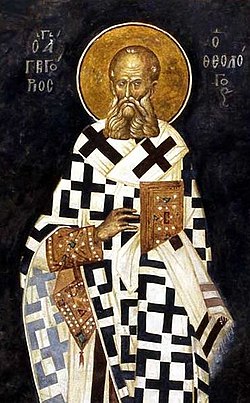Top Qs
Timeline
Chat
Perspective
January 25 (Eastern Orthodox liturgics)
Day in the Eastern Orthodox liturgical calendar From Wikipedia, the free encyclopedia
Remove ads
January 24 - Eastern Orthodox liturgical calendar - January 26

All fixed commemorations below are observed on February 7 by Orthodox Churches on the Old Calendar.[note 1]
For January 25th, Orthodox Churches on the Old Calendar commemorate the Saints listed on January 12.
Saints
- Venerable Castinus of Byzantium, Bishop of Byzantium (240)[1][2][3]
- Martyr Medula and her entourage.[3][4]
- Venerable Apollo of the Thebaid, ascetic and wonderworker, reposed in peace (ca. 361-363)[1][3][5]
- Saint Bretanion (Vetranion), Bishop of Tomis in Moesia, Confessor (ca. 380)[1][6][note 2]
- Venerable Publius of Syria, ascetic of Euphratensis in Syria (380)[1][3][8][9]
- Venerable Theodotos, Igumen of the "Monastery of St. Publius".[3][10]
- Saint Gregory the Theologian, Archbishop of Constantinople (390)[1][3][11][12][13]
- Venerable Mares the Singer, of Omeros near Cyrrhus (430)[1][3][14][15]
- Venerable Demetrius the Skevophylax ("Keeper of the Sacred Vessels") of Constantinople (8th century)[1][3][16]
Remove ads
Pre-Schism Western saints
- Martyrs Felicitas of Rome and seven sons (ca. 164):[1][17][18] (see also: November 23 in the West)
- Januarius, Felix, Philip, Silvanus, Alexander, Vitalis, and Martial.[18]
- Saint Artemas, a child martyr in Pozzuoli (Puteoli) in Italy.[18]
- Saint Dwynwen of Llanddwyn Island, Patroness of Love and Marriage (c. 460)[18][19][note 3]
- Saint Eochod of Galloway, Apostle of the Picts of Galloway (597)[18][note 4]
- Saint Maurus (584) and Saint Placidus (6th century), early disciples of St Benedict.[18]
- Saint Sigeberht of East Anglia (Sigebert), the first Christian King of East Anglia in England (634)[18][20][note 5]
- Saint Racho of Autun (Ragnobert), Bishop of Autun in France (ca. 660)[18]
- Hieromartyr Praejectus (Priest, Prest, Preils, Prix), Bishop of Clermont (676)[1][18][note 6]
- Saint Amarinus, Abbot of a monastery in the Vosges in France, and companion in martyrdom of St Praejectus (St Priest) (676)[18][note 7]
- Saint Thorgyth (Tortgith), nun at the convent of Barking in England with St Ethelburgh (ca. 700)[18][note 8]
- Saint Poppo of Stavelot, Abbot of Stavelot-Malmédy in Belgium, renowned for miracles (1048)[7][18][note 9]
Remove ads
Post-Schism Orthodox saints
- Saint Moses of Novgorod, Archbishop of Novgorod (1362)[1][21][22][note 10] (see also: April 19 - Translation)
- Saint Gregory of Golutvin (15th century)[1][23][note 11]
- Saint Basian, Archbishop of Rostov (1516)[24] (see also: March 23)
- New Martyr Auxentius of Constantinople (1720)[1][3][25][26]
- Saint Anatole I (Zertsalov) of Optina Monastery, Elder of Optina (1894)[1][12][27][28]
- Saint Gabriel, Bishop of Imereti (Georgia) (1896)[1][29][30]
New martyrs and confessors
- New Hieromartyr Vladimir (Bogoyavlensky), Metropolitan of Kiev, Protomartyr of the Communist yoke in Russia (1918)[1][12][23][31][32]
- Venerable New Martyr St. Elizabeth Romanova (Princess Elisabeth of Hesse and by Rhine (1864–1918)) (1918)[33]
- Venerable New Martyr Abbess Margaret (Gunaronulo) of Menzelino (1918)[1][23][34]
- New Hieromartyr Peter (Zverev), Archbishop of Voronezh (1929)[1][12][23]
- New Hieromartyr Basil (Zelentsov), Bishop of Priluki (1930)[1][12][23]
- New Martyr Athanasia (Lepeshkin), Abbess of the Smolensk Hodigitria Convent, near Moscow (1931)[1][23]
- New Hieromartyr Stephen Grachev, Priest (1938)[23]
- New Martyr Boris Zavarin (1938)[23]
Other commemorations
Icon gallery
- Saint Gregory the Theologian, Archbishop of Constantinople.
- Saint Maurus (584), early disciple of St Benedict.
- Plaque commemorating St. Praejectus (St. Pry), at Saint-Prix, Val-d'Oise.
- New Hieromartyr St. Vladimir (Bogoyavlensky), Metropolitan of Kiev, Protomartyr of the Communist yoke in Russia.
- New Hieromartyr St. Vladimir (Bogoyavlensky), Metropolitan of Kiev, Protomartyr of the Communist yoke in Russia.
- Venerable New Martyr St. Elizabeth Romanova (Grand Duchess Elizabeth Fyodorovna).
Remove ads
Notes
- The notation Old Style or (OS) is sometimes used to indicate a date in the Julian Calendar (which is used by churches on the "Old Calendar").
The notation New Style or (NS), indicates a date in the Revised Julian calendar (which is used by churches on the "New Calendar"). - Born in Wales, churches dedicated to her are to be found in Wales and Cornwall. Her holy well and shrine at Llanddwyn in Anglesey were once centres of pilgrimage.
- One of St Columba's twelve companions, he was chosen to enlighten the Picts in Scotland. He is called the Apostle of the Picts of Galloway.
- The first Christian King of East Anglia in England. He introduced Orthodoxy into his kingdom, later himself becoming a monk. He was killed by the pagan King Penda of Mercia and was venerated as a martyr.
- He became Bishop of Clermont in Auvergne in France. He encouraged monasticism but was murdered by evildoers at Volvic in the Vosges.
- She is described as a miracle of patience under suffering.
- Born in Flanders, after a military career he made a pilgrimage to Jerusalem and Rome. On his return he became a monk at St Thierry in Rheims in 1006. Two years later he moved to Saint-Vannes and then to Vaast in Arras. In 1021 he became Abbot of Stavelot-Malmédy in Belgium and the monastic revival soon spread to other monasteries, among others to Hautmont, Marchiennes, St Maximinus of Trier in Germany and St Vaast in Arras in France.
- See also: (in Russian) Моисей (архиепископ Новгородский). Википедии. (Russian Wikipedia).
- See also: (in Russian) Григорий (епископ Коломенский) («Григорий Голутвинский»). Википедии. (Russian Wikipedia).
Remove ads
References
Sources
Wikiwand - on
Seamless Wikipedia browsing. On steroids.
Remove ads







